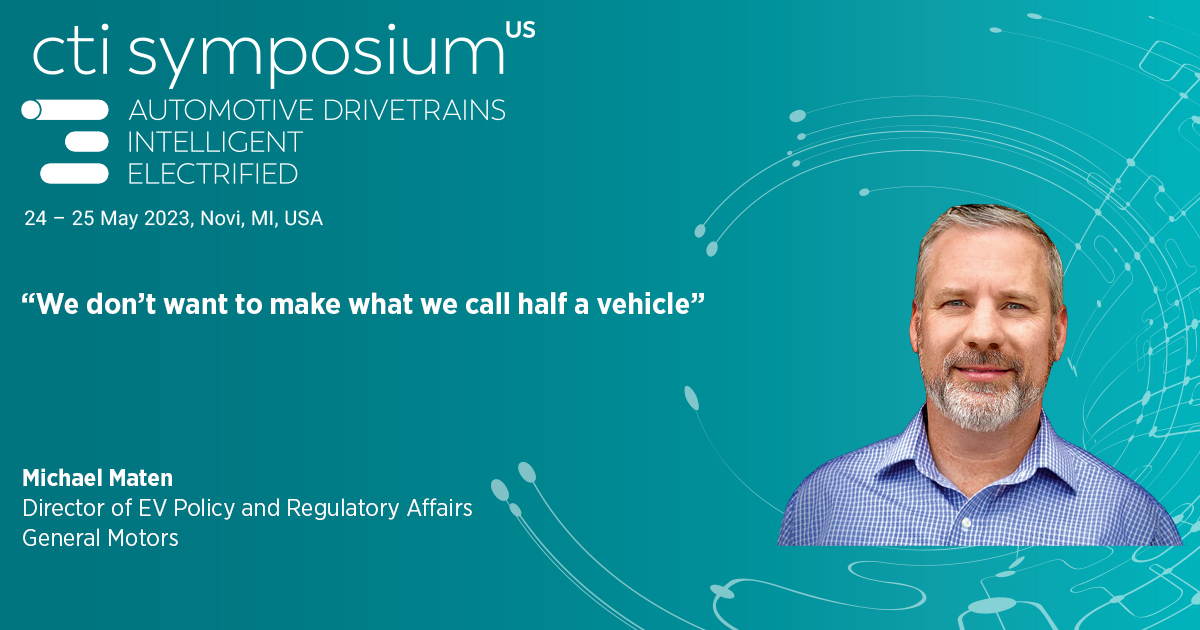
General Motors has been a pioneer in the area of range extender technology, but today it is focusing on all-electric vehicles. We spoke with Michael Maten, Director EV Policy and Regulatory Affairs at GM, about the company’s electrification path, and future development challenges in fields such as the production, transport, and storage of energy.
Mr. Maten, electrification is transforming the industry rapidly. At GM, which manufacturing and engineering fields are becoming less significant, and which more so?
I think both engineering and manufacturing competencies are becoming even more important. They are both necessary as we continue to electrify things. Electrical engineering and software engineering in particular are becoming more important. Mechanical engineering still plays an important role, but maybe a little less so. On the manufacturing side, it’s a really exciting time – to be right at the beginning of a new industry. Instead of just working around the margins to optimize things like the combustion engine, you truly get this ground floor, you’re building the foundations for the next hundred years of the auto industry. Many engineers who worked on ICE programs are now bringing that expertise to EV programs. And there’s another new aspect: In the past, manufacturing and engineering stopped at the factory doors, once that vehicle left the factory. Now our involvement doesn’t stop at the factory door, because we have over-the-air updates. We are constantly trying to optimize the vehicle, to add features to the vehicle.
What advantages does GM have in this transition, compared to newcomers in the market?
It starts with our size and scale and know-how. The fact that we can quickly bring things to an enormous scale, brings the cost down, to improve the technology, I think that’s a huge advantage. Our modular Ultium platform, which I was involved in planning back in 2017, can be used for a wide range of vehicles. It can adapt to different battery formats and chemistries. It can really be the foundational element for several generations of General Motors vehicles. We are actually building the vehicle around the platform, around the battery, instead of trying to shove a battery into an existing vehicle architecture. I would add that we think we’re the best in the business at generating efficiency throughout the supply chain. Taking what we’ve done in optimizing the supply chain over the last hundred years of ICE development, bringing that level of knowledge, that level of rigor, the level of process to the lithium-ion battery space. It’s still very much what I call a cost-plus industry and not optimized. But we have the experience to handle that.
Your Silverado is a genuine e-truck. How do you ensure sufficient range for a vehicle that’s often used for towing trailers or transporting heavy loads?
Well, we’re designing it not only for 300 miles, but with a 400 miles range in mind to address some of those concerns. We know there are some challenges when you’re towing, and some challenges with temperature variation. We are trying to address all of those with the technology we are putting in the truck. We’re still figuring out, especially for the American consumer, what their kind of crossover point is. I think everyone feels that 300 miles will get most people into an electric vehicle. But there are certain people, in Wyoming or Montana or elsewhere, who say man, I really need 400. But we are committed to the transformation, we think the battery cost curve is coming down. We think the battery technology is getting to a place where we can effectively offer those types of products. I should also say it’s not just about battery chemistry. We are taking an overall vehicle approach. How can we efficiently heat and cool the cabin, things like this. There are many important factors in the overall equation of the range capabilities of the vehicle.
In North America, temperature extremes are much greater than in Central Europe. What are the solutions for reducing negative impacts on range – e.g. through air conditioning and heating?
Certainly, heating is almost a bit of a forgotten area. But we’re focusing on it from a research perspective, whether it’s conductive surfaces like conductive door panels, armrests, or dashboards. I’m not saying this is technology that’s coming out tomorrow in vehicles. But you just have to look at it as a whole system. And how are we doing this? In an internal combustion engine, you’re generating a lot of waste heat that can be used. So now we’re just beginning to explore the capabilities of BEVs and how those all work. Preconditioning is going to play a large part. You know, you’re plugged into an energy source. And when you’re charging, that can be used to precondition the cabin and the battery, you can program when you leave in the morning. I think it’s going to be a key technology, particularly in colder climates. We see in Norway that people in colder climates can adapt to EVs. So you just have to figure out what it is for the American consumer that will cause them to do that. Extreme temperatures are something that a lot of research is going into how to handle that.
What opportunities do you see for hydrogen and e-fuels in the area of passenger cars and light trucks?
I think there are going to be applications in the future that will be the last to adopt electrification. E-fuels could potentially play a role in some of those. Quite frankly, we don’t see hydrogen playing a large role in passenger cars and trucks. But it will play an important role in the overall decarbonized economy, for stationary storage, potentially for medium and heavy-duty vehicles. At GM we have our Hydrotec fuel cell. We have a commercial agreement with Navistar to provide those. But green hydrogen, I always have to preface that, is another area where we need technical and cost improvement. However, in a decarbonized economy, in the passenger car and truck case, we see a potential role for stationary energy storage to support infrastructure. In other words, for somewhere where you can’t quite get all of the energy for 350 kW charging, you may put a hydrogen fuel cell storage unit there, or maybe a large stationary storage battery. This is one of the most important questions: How do we store and transport energy? In America, the middle of the country is rich in renewable energy, wind and solar energy. You can generate a lot there. But unfortunately, the use for most of that energy is on the coast. I think batteries can play a massive role in the stationary storage of energy. Some people don’t quite understand the amount of energy in it. You know, the Hummer EV can power a home for a week.
GM has been a PHEV pioneer, even if the Volt was originally intended as an E-REV. What future do you still see for PHEVs?
We made the decision that we want to accelerate the EV transition, and we felt even hybrids – PHEVs but especially hybrids – are transition technology. If we had $1 billion to spend, we didn’t want to spend it on a technology that might be going out after one generation. Yes, we were a leader in plug-in hybrids or E-REVs, but for a couple of reasons it was a difficult value proposition for customers to understand. Engineers understand the operation, but the customer now had to manage two energy sources and we never quite got the demand that we thought was there. Another aspect is the regulatory angle. We never quite got the regulatory treatment we felt we deserved for PHEVs, especially the E-REV, as 90% of its operation was in electric mode. Again, everything is regulations in the EU and the US, as you know. But primarily it was just a 100% focus on electric vehicles and what we would take to get there.
To what extent will small, affordable vehicles still be available as electrification moves forward?
We plan an offering of a wide range of vehicles. But we do not plan an offering of lower-range vehicles that have less utility, just to hit a certain price point. These vehicles are not going to have as much utility to a customer. We believe these longer-range BEVs are the way to go, and yes, it is a challenging price point to hit. We’ve committed to an Equinox starting at $30,000 next year. And we have the Bolt EV out there, the 2023 range starting from just $26,595. So we think we’re covering most price points. I think we’ve also made allusions to future developments of more affordable vehicles. We are a full-line manufacturer, and we plan to continue that into the BEV space. And that includes being committed to that lower end of the market. What we don’t want to do is make what we call half a vehicle.
Interview: Gernot Goppelt
